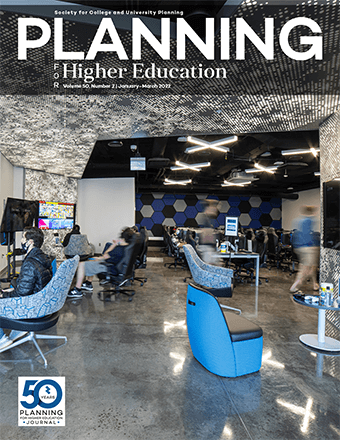- Integrated Planning
Integrated Planning
Integrated planning is a sustainable approach to planning that builds relationships, aligns the organization, and emphasizes preparedness for change.
- Topics
Topics
- Resources
Resources
Featured Formats
Popular Topics
- Events & Programs
Events & Programs
Upcoming Events
- Building Buy-in for Planning: Dealing With Resistance and Gaining Support
Online | March 11 – April 8 - Budgeting for Impact: A Working Group on Resource Planning in Higher Education
Online | Feb 5, Feb 19, March 5 - Cross-Functional Collaboration: Tools and Skills for Working Across Silos
Online | February 10, 17, 24
- Building Buy-in for Planning: Dealing With Resistance and Gaining Support
- Community
Community
The SCUP community opens a whole world of integrated planning resources, connections, and expertise.
- Integrated Planning
Integrated Planning
Integrated planning is a sustainable approach to planning that builds relationships, aligns the organization, and emphasizes preparedness for change.
- Topics
Topics
- Resources
Resources
Featured Formats
Popular Topics
- Events & Programs
Events & Programs
Upcoming Events
- Building Buy-in for Planning: Dealing With Resistance and Gaining Support
Online | March 11 – April 8 - Budgeting for Impact: A Working Group on Resource Planning in Higher Education
Online | Feb 5, Feb 19, March 5 - Cross-Functional Collaboration: Tools and Skills for Working Across Silos
Online | February 10, 17, 24
- Building Buy-in for Planning: Dealing With Resistance and Gaining Support
- Community
Community
The SCUP community opens a whole world of integrated planning resources, connections, and expertise.
 Planning for Higher Education Journal
Planning for Higher Education JournalPartnerships Promote Inclusion
A university and a secondary school collaborate to decrease dropout rates and increase college enrollment From Volume 50 Number 2 | January–March 2022By Vibhavari Jani, MA, and Tim Murrell, EdDPlanning Types: Academic Planning, Diversity, Equity, and Inclusion PlanningChallenges: Student Success, Retention, and GraduationTags: Active Learning, Attracting and Retaining Underrepresented Students, Collaborative Design, Design Thinking, Diversity Equity and Inclusion (DEI), Experiential Learning, External Collaboration / Partnerships, Fine and Performing Arts Education, K–12, Student Success, Teaching and Learning, Workforce Development
From Volume 50 Number 2 | January–March 2022By Vibhavari Jani, MA, and Tim Murrell, EdDPlanning Types: Academic Planning, Diversity, Equity, and Inclusion PlanningChallenges: Student Success, Retention, and GraduationTags: Active Learning, Attracting and Retaining Underrepresented Students, Collaborative Design, Design Thinking, Diversity Equity and Inclusion (DEI), Experiential Learning, External Collaboration / Partnerships, Fine and Performing Arts Education, K–12, Student Success, Teaching and Learning, Workforce Development
Institutions referenced in this resource:
Kansas State UniversityAmerican industries, professional organizations, individual companies, and higher education institutions continue to struggle to attract employees from underrepresented populations. Future-forward thinking is required to ensure a multicultural workforce. The authors, a design educator at a predominantly white, Midwestern university, and a high school principal at a multicultural urban school district, developed an intentional collaboration—partnerships between secondary and postsecondary institutions—to bridge the gap. In this article, they share strategies they developed for recruiting and retaining underrepresented students through intentional planning and design of competency-based, personalized learning models.
MEMBERS ONLY
Attention Members: Log in to access this item.Not a member? Join now to access this article and all journal articles for free. - Topics
- Topics


